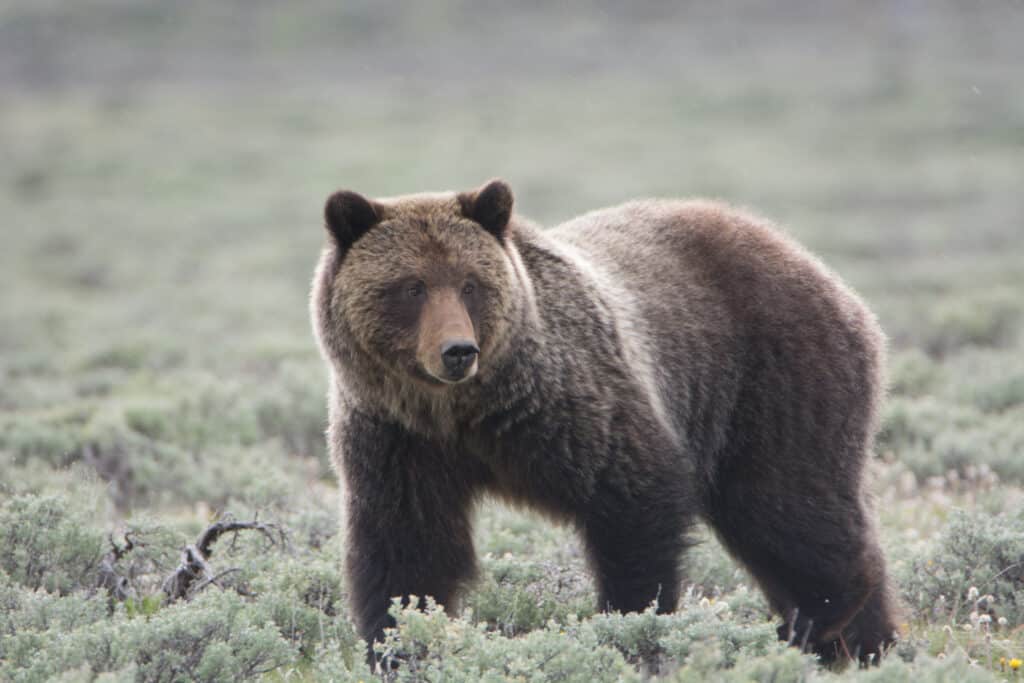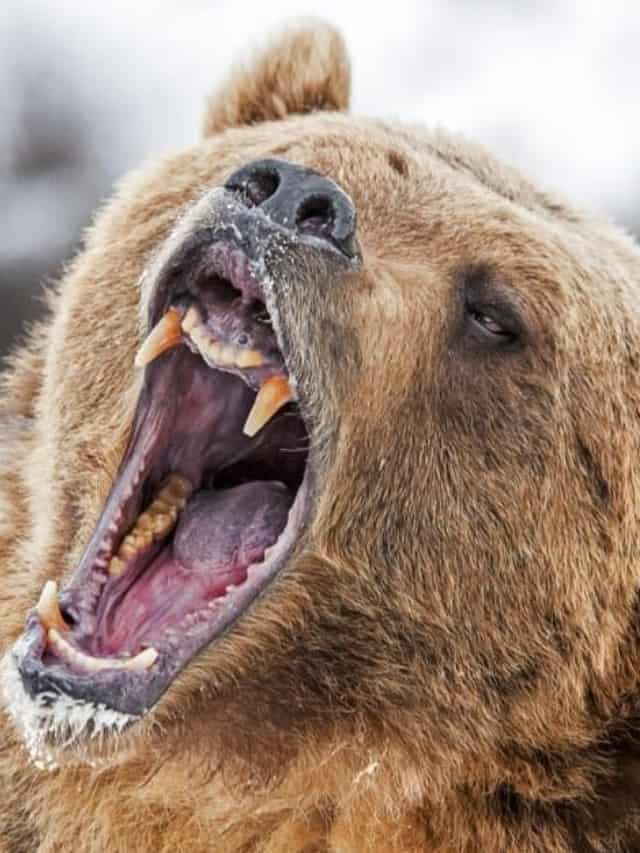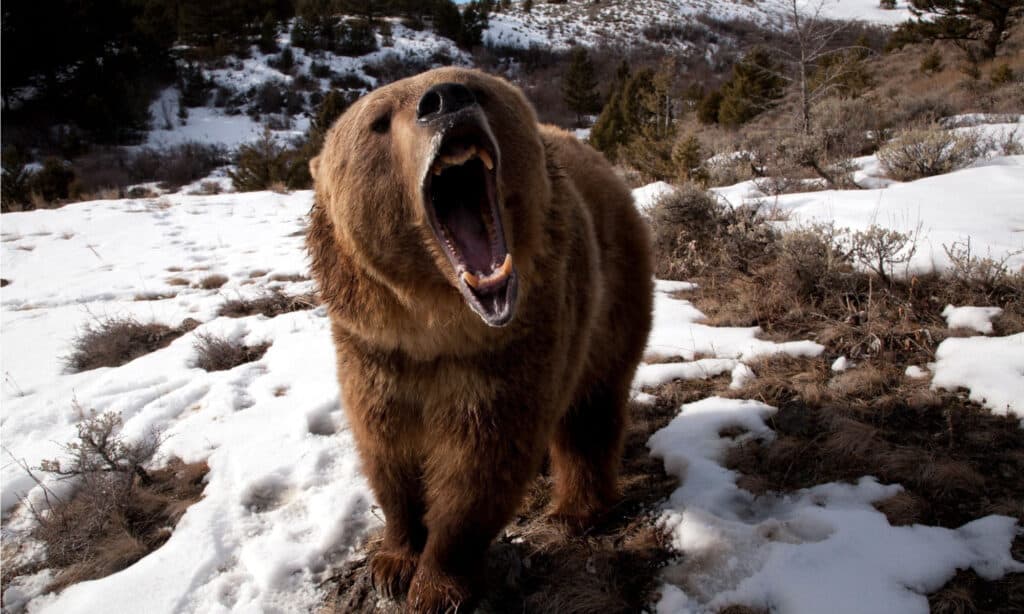Grizzly bears are generally considered one of North America’s greatest predators. These intelligent and powerful creatures once roamed huge swathes of the United States, but human interference has pushed them into smaller and more isolated regions.
Still, despite us, grizzlies are still around in the continental United States and seem to be spreading out again as their population rebounds.
Today, we will look at grizzly bears in Montana and find out where they live. Let’s begin!
Where Do Grizzly Bears Live in Montana?

Grizzly bears live in the western portion of the state of Montana.
©Jilll Richardson/Shutterstock.com
Grizzly bears live in the western portion of the state of Montana.
In the United States, grizzly bears only live in a few select places, especially when you only consider the contiguous US (not including Alaska and Hawaii). One of the few small remaining population centers for grizzly bears is in Montana.
As it stands, between 1,800 and 2,000 bears live in the state, a reflection of the hard work Montana has done to protect and help the population recover. In fact, Montana is home to the highest number of grizzly bears populations in the United States besides Alaska.
Almost all of the grizzly bear sightings in Montana occur in the western portion of the state, although a few sightings in the far east occasionally occur. Nearly all grizzly bears living in Montana as permanent residents live west of Yellowstone County, the most populous county in the state.
This county is found just east of Yellowstone National Park, although it gets its name from the Yellowstone River, which bisects the county, not the park itself.
The highest density counties for grizzly bears, roughly from east to west, are Carbon County, Gallatin County (with its southern tip dipping into Yellowstone National Park), Madison County, Lewis and Clark County, Missoula County, Glacier County, Flathead County, Lake County, Park County, and Lincoln County.
Grizzly Bear Habitat

Grizzly bears have an incredibly strong sense of smell, which they use to locate food. In fact, a grizzly bear’s sense of smell is about 7 times stronger than a bloodhound’s, and they are able to detect food from over a mile away.
©Scott E Read/Shutterstock.com
Grizzly bears are so large that they require specific habitats in order to maintain a healthy lifestyle. In Montana, the most common habitats for grizzly bears include meadows, seeps, shrub fields, timber stands, and alpine regions.
Generally, the individual grizzly and the time of the year determine which type of habitat they are most likely going to be found in.
Before human engagement, grizzly bears were mostly a plains-dwelling species. Humans and their habitation of these zones pushed grizzly bears into more isolated regions.
When grizzly bears create their dens (their longer-term homes), they have a certain habitat they prefer. In Montana, grizzly bears will place their dens along the middle to upper one-third of a slope measuring 30-60 degrees with a northern exposure between an elevation of 6,000 to 10,000 feet.
This highly specific pattern of behavior has been observed repeatedly, although it isn’t something that all bears do every time they create a den.
Grizzly Bears and Their Historic Range in Montana

Before humans, grizzly bears could be found in relatively high densities across the entire state of Montana from east to west.
©Falade Adewale/Shutterstock.com
Although they are mostly found in the western portions of the state, grizzly bears once had a much larger range. In fact, before humans, grizzly bears could be found in relatively high densities across the entire state of Montana from east to west.
Today, their range is mostly restricted to protected regions and national parks along the western portion of the state. As grizzly bear populations recover and further protection is implemented, they may expand further and further east into their historic homeland.
How to Avoid Getting Attacked by a Grizzly Bear in Montana
Despite having some of the highest population densities of grizzly bears in the United States, being attacked by a grizzly is still very unlikely. The vast majority of bears live in Alaska, and those in Montana are mostly concentrated in Glacier and Yellowstone National Park. Still, here are some tips:
First, always ensure that you announce your presence when you are in grizzly habitat. Occasionally shouting, yelling, and talking loudly are great ways to let bears know you are in the area. Generally, grizzly bears will avoid you as long as you are there. If you surprise them, however, they could react violently.
Second, never approach a bear, especially cubs. Almost all bear attacks are spurred on by a mother with cubs, so if you see cubs, slowly leave the area without running. Once you are away, notify authorities there is a mother with cubs so they can handle it appropriately.
If you are camping, ensure proper food storage protocols are followed. If a bear wanders into your camp, it’s interested in food, not you. Storing it correctly can help to reduce any bad interactions that could occur.
What Other Apex Predators Live in Montana?

Mountain lions
and grizzly bears have overlapping habitats in some areas of Montana, and they can sometimes come into conflict over resources, such as food and territory. Although mountain lions are typically solitary animals, they are capable of killing young grizzly bears, while adult grizzly bears are often able to defend themselves against mountain
lion
attacks.
©Chris Desborough/Shutterstock.com
In addition to the grizzly bear, Montana is also home to several other apex predators, including:
- Gray Wolf: The gray wolf is a top predator in Montana, and it plays an important role in maintaining the balance of the state’s ecosystems by controlling the populations of ungulates, such as deer and elk.
- Mountain Lion: The mountain lion, also known as a cougar or puma, is a large carnivore that is native to Montana. It is an opportunistic predator that feeds on a wide variety of prey, including deer, elk, and smaller mammals.
- Bald Eagle: The bald eagle is a bird of prey that is commonly found in Montana, and it is known for its powerful talons and keen eyesight. Bald eagles feed on fish, small mammals, and carrion, and they are considered an apex predator in their habitats.
- Golden Eagle: The golden eagle is another bird of prey that is native to Montana, and it is known for its strong wings and powerful talons. Golden eagles feed on a variety of prey, including small mammals, birds, and reptiles, and they are an important predator in their habitats.
These are just a few of the many apex predators that can be found in Montana, and each plays a unique and important role in maintaining the balance of the state’s ecosystems.
Whether you are a wildlife enthusiast, birdwatcher, or just someone who loves the great outdoors, Montana is an excellent place to explore and observe these fascinating creatures.
Where Else Do Grizzly Bears Live in the United States?
There are only four other states in which grizzlies live: Alaska (30,000), Idaho (80-100), Washington (500), and Wyoming (600). These numbers are, of course, estimates and are far from the 55,000 total that supposedly live in the United States.
While grizzly bears once lived in most parts of the country, hunting and habitat loss have greatly decreased their numbers. To prevent extinction, certain areas have been designated as protected ecosystems for them: the Northern Continental Divide, the Cabinet-Yaak Ecosystem, the Northern Cascades, and the Bitterroot. Yellowstone National Park was also one of these protected ecosystems until 2016 when it was determined that the population of grizzly bears there had become stable.
Canada has about 25,000 grizzlies living in British Columbia, the Rocky Mountains of western Alberta, the Yukon, the Northwest Territories, southwestern Nunavut, and northern Manitoba.
The photo featured at the top of this post is © Perpis/Shutterstock.com
Thank you for reading! Have some feedback for us? Contact the AZ Animals editorial team.






